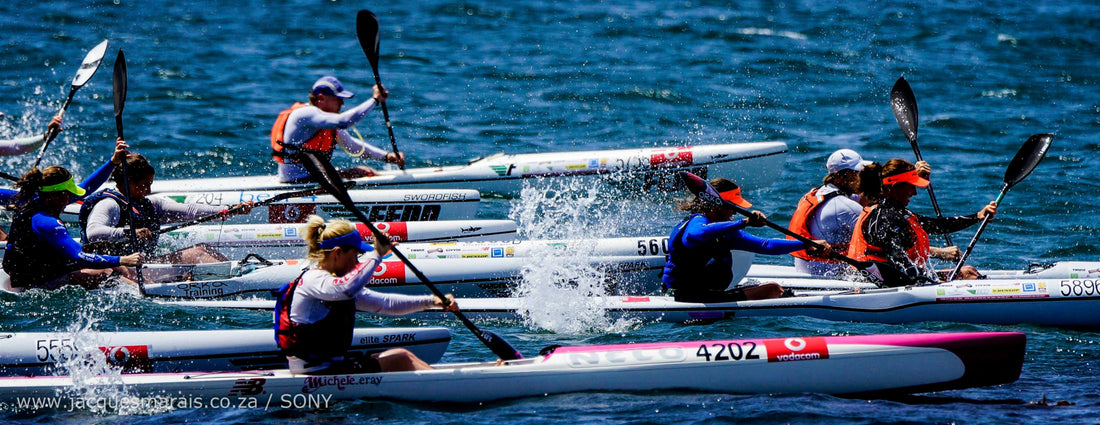
Choosing a surfski - as seen in the ACA eMagazine June 2017
Share

Surfski design and manufacturing has come a very long way since the days of Magnum P.I. crossing the Channel of Bones during the Molokai Challenge event in his old-school, double –foot well, spec surfski!
The companies of today are developing lighter, stiffer, and ultimately faster surfskis. They are achieving this through innovative design, improved construction, more durable materials, and topped off with quality workmanship. This is all great for us who like to paddle!
So which is the right surfski for you?
There are a number of factors to consider when choosing your future boat, and I will cover them below.
#1. The surfski should match your ability level
"Ability should match stability."
Dawid Mocke, Cape Town, South Africa
There is no point (and no fun) in spending the majority of your paddling session remounting your ski. It is designed to be paddled, and too often we see paddlers choosing the fast, skinny “racing snake” over something more stable, and then not enjoy paddling that much. The irony of choosing a faster ski over a more stable one, is that you will actually go faster in the more stable ski (no one is fast when spending the time falling out or having to take brace strokes all the time and wasting energy trying to stay upright!)
Unless you are in the Top 5% of paddlers in the world, who spend upwards of 20 hours a week training (read: perfecting their balance), you should be in something more stable.
All manufacturers have a range of surfskis – entry level, intermediate, and racing. Make sure you try before you buy, and of course, be sure to try it in the conditions you will primarily paddle in (e.g. a bumpy ocean or flatwater lagoon). A ski that feels good in the flats, might just be really tippy in the ocean.
#2. Surfski Construction

The construction – materials used as well as manufacturing method - of a surfski will have two important results, the weight of the ski and how rigid it will end up being.
I won’t go into too much detail but what you need to know is that a light ski has a few advantages, and you should weigh up whether the extra dollars are worth it. What makes a ski light is usually how much carbon has gone into it.
Carbon is an incredibly lightweight but strong material, giving surfskis both lightness and rigidity. The advantages of a light ski mean it’s less to push through the water. If you weigh under 130 lbs that will have a bigger impact on your paddling speed than if you are more in the 180 and up category. Think of it as a percentage of your body weight. For the extra $1000 or so, it might be worth dropping a few pounds of body weight rather, or not! A lighter ski is definitely easier to carry though.
Rigidity is a big factor in boat speed, and the more rigid the ski, the less energy displacement there will be, i.e. the faster you will go for the effort you put in. If you are looking for that small gain when racing, then make sure you are getting a well-made, vacuum and heat cured boat. If cruising the waters of your bay is what you had in mind, then that can be less of a factor.
Plastic

A few of the major brands including Nelo, Epic and Think all make a rotomolded plastic surfski. Although on the heavier side, these skis bring a totally different aspect to the sport.
They are more durable and can handle a few drops and knocks on rocks (they can even go down rivers with a pop-up rudder installed). And they have a great price point, meaning you won’t break the bank.
The only plastic ski I have paddled is the new Nelo 510, and it is actually pretty fast, and surfs the downwind runs really well!
This helps with getting more people into the sport, as it is cost effective, and the boats are really stable, helping speed up the learning process.
#3. Sitting position and customization
To optimize your technique and the ability to use your whole body to power your stroke, your ski choice has to have a seated position that fits you.
For good leg drive and therefore rotation, you need to be able to move your legs freely. Having a large hump under your knees will restrict your leg movement. If the ski is not adjustable (which all new skis are these days) make sure the leg length fits you.
Another important aspect is the seat bucket width – you need to be able to move for rotation, but if it is too loose, you will lose stability.
Ideally, you should fit the ski to you, and not the other way around. Worst case, make sure you can customize the ski a little without affecting its performance, by adding foam to the seated area.

Michele showing great leg drive due to the fantastic setup in the Nelo.
#4. Fittings
As important as a solid construction is, when your steering cable snaps you will wish you had checked out all the fittings! Good quality stainless steel, or strong manufacturer approved string, and durable hard plastic 3D printed parts go a long way to ensure your whole ski is safe and has longevity. It’s useful to have extra bungee cord attachments for storing gear, and a place to attach your safety leash. Make sure you check for these before you buy.
Some manufacturers add a lot of extra value with quality extra's.
#5. Personal design
Certain manufacturers offer you the choice of designing the exterior of your new boat, and being able to pick colours and designs of your choice is a fun element which really adds to the excitement of personalizing your own craft. Not only will it be unique, but it could add value.

#5. After sale service and warrantee
Manufacturers will back their products against defects, so be sure to check out how long the warrantee is valid for and what is actually covered. The higher the quality, usually the longer the warrantee.
Being able to get parts or extra fittings is important, therefore it’s a good idea to go with a reputable and well managed brand, which has excellent after sales service. Make sure there is someone local that represents the brand, allowing quick and easy access to spare parts.
I hope these tips have helped you make an informed decision before you purchase your next surfski.

